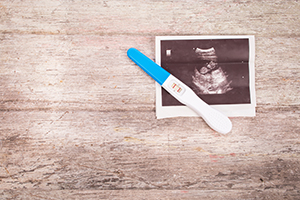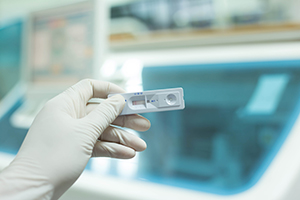Throughout recorded history, humans have endeavored to find a way to test if a woman is pregnant. For thousands of years, cultures recognized that clues could be discovered by inspecting a woman’s urine. But it has only been in the last 100 years since the discovery of hormones associated with pregnancy, and an effective means to test for them, that the age of modern pregnancy testing truly took off.
The last 20 years in particular have been a period of innovation in creating the modern pregnancy kit. Key to the development of this product—which is used by millions of women each year—has been the invention of a test methodology known as lateral flow. It is due to this technology that women today can use a simple test kit and learn whether she is pregnant within minutes, with a 99 percent accuracy rate.
Truly, we’ve come a long way. But the journey was long.
URINE TESTING AS ANCIENT AS THE PYRAMIDS
Sampling urine to determine pregnancy dates at least as far back as Ancient Egypt. Based on writings that have been discovered, Egyptians believed that if a woman urinated on wheat and barley seeds, her pregnancy could be detected by growth that occurs. If the barley seeds sprouted and grew, it meant she was pregnant with a male, while wheat sproutings meant a baby girl was on the way. If nothing grew, she was not pregnant (1).
While modern pregnancy testing is much quicker and more accurate, Ancient Egyptians were onto something when they realized pregnancy could be determined by testing a woman’s urine. By the early twentieth century when modern biology discovered the existence of hormones, researchers eventually realized that a woman’s body produced a hormone called human chorionic gonadotropin (hCG) after an egg is fertilized, and that these hormones were present in urine. The trick was finding a way to detect whether hCG was present in urine.
In 1927 a bioassay called the “A-Z Test” became the first test to determine a woman’s pregnancy. The test worked by injecting a woman’s urine into an immature rat or mouse. If the rodent had a resulting estrous reaction, in other words went in heat, it implied the presence of the hCG hormone in the urine and pregnancy. By the 1930s, in addition to rodents, rabbits, frogs, and toads became the unfortunate test subjects of bioassays to determine whether ovulation could be induced. The notion of the so-called "Rabbit Test" dates back to this time (2). Unfortunately, these tests were expensive, time consuming and not always accurate. What's more, they resulted in the sacrifice of the animals that were tested.
By the 1950s and 1960s the science of testing had progressed, and eventually these bioassays were replaced by immunoassays to test for the presence of hCG. By the 1970s, when pregnancy testing became more widespread, Wampole's two-hour pregnancy test was developed. While this was still a laboratory test, it was faster and cheaper than previous testing.
It was not until the late 1970s that the first pregnancy kits for home use were approved by the U.S. Food & Drug Administration. While offering women the convenience of testing at home for the first time, these kits were essentially mini chemistry sets that required users to mix urine with solutions in test tubes and wait two hours for a result. In addition to being somewhat complex to use, results were not always reliable; the percentage of false negatives was as high as 20 percent.

TESTING BREAKTHROUGH POSSIBLE WITH LATERAL FLOW TECHNOLOGY
By the 1990s, testing technology had advanced to the point where home kits finally began to resemble the ones used today. The mixing chemical kits were replaced with a simple test strip with a hand-held applicator, and results were indicated in approximately 10 minutes.
Lateral flow testing, also called the lateral flow immunochromatographic assay, was the technological breakthrough that significantly simplified the at-home pregnancy test, enabling greater sensitivity while reducing high error rate. It eliminated the need for users to deal with messy mixing of chemicals with the previous home kits, and it also proved to be much more reliable.
A lateral flow test works by collecting a sample of fluid, which then runs along a strip composed of porous material until it reaches a so-called “reaction zone” of binding sites in which the porous media have been coated with molecules that react to analytes in the fluid. This reaction then leads to a “positive” indication that is visible. In the case of a pregnancy test, the fluid sample is urine collected from a urine stream or from urine collected in a container. The “reaction zone” is coated with antibodies that react to the presence of hCG hormones, indicating a color change and a “positive” reading. If no hCG is detected in the sample, there is no reaction and no color change, thus rendering a “negative” test result.

NOT ALL KITS ARE CREATED EQUAL
While lateral flow technology is the mechanism of action of the modern home pregnancy test, kits need to have the right materials and design, and especially the right media to yield the most accurate results. As a home kit, users may make mistakes in testing, and a more optimized design can help minimize the possibility of false test results due to improper use. Some problems with flow can occur if too much urine is sampled, which leads to backflushing and “flooding” of the test strip. Or, there could be too little sample collected and therefore not enough to flow to the binding sites.
Problems can start with a wick that is inadequate. When this is the case, urine samples are not absorbed properly and flow to the binding site can be impeded. Each kit manufacturer uses proprietary antibodies for capturing hGC hormones, and these chemistries need to be sensitive to avoid binding to non-specific antibodies or to contaminants that may result in a false reading. It is important for media in a test trip to have precise capillary structures and chemistries that enhance wicking, absorption and flow. Wicks made from porous polymers can help manage sample flow to the reaction zone more efficiently and improve test sensitivity. This results in the optimal “capillary action” that enables the controlled delivery of a collected sample quickly to deliver a more accurate diagnosis.
Today, Porex’s pregnancy and ovulation wicks are considered the industry standard and are designed using diverse raw material options and customized geometries. Through proprietary color change and other technologies, the Porex collection media can be engineered to meet specific test platform requirements and allow for methodology assurance through accurate, precise and rapid diagnosis.
Throughout the ages, the question, “Am I pregnant?” has been one of the most urgent and emotional queries a woman could ask. With innovations like Porex’s collection media helping to ensure a quick and reliable test, it is empowering to know that the answer can be determined safely, conveniently, and with the utmost accuracy.
To learn more about customizable wicking components made from porous polymers, visit porex.com.
REFERENCES
- "A Timeline of Pregnancy Testing," National Institutes of Health (NIH). https://history.nih.gov/exhibits/thinblueline/timeline.html (accessed 2/2/20).
- "The History of the Pregnancy Test from Rabbit Tests to Websites," https://www.early-pregnancy-tests.com/history (accessed 2/2/20).
Industry Insights articles are created and paid for by advertisers. The views expressed in these articles do not necessarily represent AACC’s views, and their inclusion in CLN is not an endorsement by CLN or AACC.